As a service to our valued customers in South Florida and the surrounding areas, Elcon Electric is happy to provide tips on handling common electrical problems. These don’t necessarily require a service call by an electrician. You can also call our in-house electrician. He may be able to help you with simple electrical problems over the phone.
Circuit Breaker Tripping Off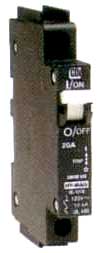
A circuit breaker is designed to trip off when it detects too much power running through the wire it’s protecting. There are three main reasons circuit breakers trip off:
- 1. There is a short circuit.
- 2. There is an overloaded circuit.
- 3. The circuit breaker is broken.
Short Circuits
Short circuits occur when two electrical wires accidentally touch each other. A short circuit will immediately cause one of your circuit breakers to trip off or one of your fuses to blow.
To fix a short circuit, ask yourself this question: “What was happening right before the short circuit?” If you had just plugged something into a receptacle (outlet) or turned on a light or an appliance, then this gives you a clue as to what caused the short.
If you just plugged in an iron, for instance, you can simply un-plug the iron and then re-set the circuit breaker or replace the fuse. If everything is now OK, then your electrical system is fine – and it’s time to get a new iron!
If, however, you can’t find anything plugged in which is causing the problem, then it’s time to call a good electrician to locate and repair your short circuit.
Overloaded Circuit
Overloaded circuits occur when too much power is running through an electrical wire. To protect the wire, the circuit breaker does its job by detecting the overload and tripping off. The solution to this problem is to remove some of the appliances that are connected to the overloaded wires. You may wish to add a new set of wires so that you can supply power to all your appliances. For this, you’ll need a good electrician.
Broken Circuit Breaker
Sometimes circuit breakers just wear out and need to be replaced. A knowledgeable homeowner with electrical skills can do the job. Otherwise, hire a good electrician.
Resetting Circuit Breakers
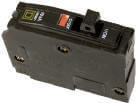
The first thing to understand is that a circuit breaker can have tripped off even when it looks like it’s in the “ON” position. This is because a circuit breaker will sometimes trip off internally, without the “ON/OFF” handle flipping to the “OFF” position.
This is what to do when you have a loss of power that you suspect may be caused by a tripped circuit breaker.
1. Shut down any computer equipment that may be affected by a loss of power.
2. Go to your circuit breaker panel and firmly flip the first breaker OFF and then back ON again.
3. Do the same thing with each circuit breaker until you have flipped all of the circuit breakers OFF and then back ON again.
4. Now check and see whether the device that didn’t have power is now back on again.
5. If your power has been restored, you’re done! If your power is still out, it’s time to call an electrician.
Note: About 25% of all electrical power problems can be solved using the above technique. Good Luck!
More Technical Stuff About Circuit Breakers
Inside most circuit breakers there are two types of protection: One is thermal. The other is magnetic. The thermal strip measures heat build-up caused by overloading. When it reaches a certain temperature, it will shut off the breaker. The magnetic coil measures sudden increases in current (such as a short). At a predetermined limit it will shut the breaker off. Older breakers sometimes have only one of these features. For maximum protection, a breaker with both types of protection is recommended.
There are usually three spots on the outside of a breaker that show wear. If the “ON/OFF” switch (located at the top) has broken off or is loose, we recommend the breaker be replaced. Next is the load lug. If it is burnt or abnormally loose, we recommend the breaker be replaced. Last, and most common, is the stab. The breaker stab is what makes contact with the bussing in the panel (the bussing carries the power throughout the panel). The stab connects to the bussing through friction and spring tension. The spring tension, over time, may break down. If so, arcing or burning may result. If the stab has become burnt, discolored, or is abnormally loose, we recommend that the breaker be replaced and that the bussing in the panel be checked.
NOTE: It is possible for a breaker to appear OK in regard to it’s outward appearance and its capacity to carry continuity, but still be questionable, bad, or intermittent. The opposite may be true as well. A breaker with a poor outward appearance may be perfectly safe and structurally sound. Therefore a decision to replace a breaker should not be based solely on appearance, continuity, age, etc. A good electrician can recommend the proper course of action based on taking into account all the relevant factors.
Determining a Panel Size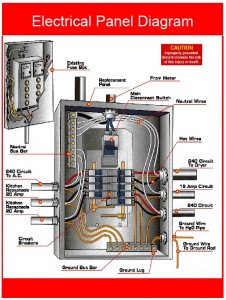
- Open your electrical panel door to access all the circuit breakers in the panel.
- Look for the large double pole circuit breaker at the top of the panel titled “Main.”
- You should find the amperage listed on the “handle” of this breaker. Most generally, the main service size will be 100, 150 or 200 amps.
NOTE – Some main panels are found outside next to the FPL meter.
Dimmers
You might notice that sometimes a dimmer seems warm when you touch it. The good news is, THIS IS NORMAL. Dimmers naturally get warm when they are in use, especially if there is more than one dimmer in the same location.
However, if a dimmer is REALLY warm or hot to the touch, this indicates a safety problem, and you should call an electrician who is knowledgeable about lighting issues
Dimmer Warning – Two things to be careful about with dimmers:
 Never connect a regular dimmer to low-voltage lights, paddle fans, or any kind or motor. These devices require special dimmers.
Never connect a regular dimmer to low-voltage lights, paddle fans, or any kind or motor. These devices require special dimmers.- Never exceed the recommended wattage of the dimmer. Regular dimmers are rated for a maximum of 600 Watts. This is equal to 10 sixty Watt light bulbs, or 6 one hundred Watt bulbs.
NOTE: You can also buy higher-wattage dimmers for connecting more than 600 Watts to one dimmer.
Energy Savings

- Replace traditional incandescent bulbs with Compact Fluorescent Light bulbs (CFLs) that have the ENERGY STAR label. You might think of these as the little swirly guys that look like soft ice cream cones. These days, you have many choices of shapes, sizes, and colors of light. CFLs cost little up front and last up to 10 times longer than a regular incandescent light bulb.Compact Fluorescent Light bulbs create savings on your electric bill. Up to 20% of the average home’s electric bill goes for lighting. Because CFLs use up to 75% less electricity than a traditional bulb, they lower your bill and provide a quick return on investment.If every home in America replaced just one incandescent light bulb with an ENERGY STAR CFL, in one year enough energy would be saved to light more than 3 million homes. This would reduce greenhouse gas emissions equivalent to taking 800,000 cars off the road. CFLs also reduce mercury emissions to 1/5th of those generated by the use of traditional incandescent bulbs.Click here for more information about saving energy with CFLs.
- Install dimmers on your lights so that when you wish less light, you can reduce the amount of electricity your bulbs draw. We can install dimmers for you and also timers, motion-detector switches, and photo-sensitive switches that automatically turn off lights when you feel that they’re not needed. Ask us about the variety of dimmers and switches that will save on your electric bill, reduce carbon emissions, and save energy.
- Install a programmable thermostat to keep your house comfortably warm in the winter and comfortably cool in the summer. You can program the thermostat to “remember” to turn off or reduce heating and cooling when you’re sleeping or not at home.
- You can shave 25% off your energy bills by replacing older appliances like air conditioners and furnaces with models that carry the ENERGY STAR label. ENERGY STAR appliances meet strict efficiency guidelines set by the U.S. Department of Energy and the Environmental Protection Agency.While Energy Star appliances may be slightly more expensive, the extra cost will be more than paid back through reduced utility bills. You will also be helping the planet.
- Air dry dishes instead of using your dishwasher’s drying cycle.
- Turn off your computer and monitor when not in use.
- Plug home electronics, such as TVs and DVD players, into power strips; turn the power strips off when the equipment is not in use (TVs and DVDs in standby mode still use several watts of power).
- Lower the thermostat on your hot water heater to 120F.
- Take short showers instead of baths.
- Wash only full loads of dishes and clothes.
- Drive sensibly. Aggressive driving (speeding, rapid acceleration and braking) wastes gasoline.
Visit www.energysavers.gov for more energy-saving ideas.
Fuses
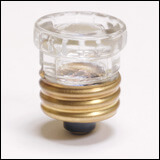
When a fuse detects too much power running through a wire, a tiny piece of metal inside the fuse will break, thereby stopping the power from continuing to run through the wire.
When the top of the fuses is made of glass, many people think that they can look at the metal piece inside and see if it is broken. THIS IS NOT ALWAYS TRUE.
The best way to handle a suspected blown fuse is to simply replace it. If the power comes back on, great! If it doesn’t, then you should call an electrician who is good at troubleshooting.
Garbage Disposal Power
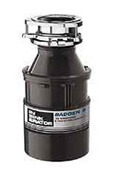
If your garbage disposal power stops working you should:
1. First, make sure the power is turned off to the garbage disposal unit by ALWAYS making sure the switch to the garbage disposal is turned to the OFF position.
2. Clear out anything inside the garbage disposal which might be jamming up the motor and stopping it from working.
3. Briefly flip on the switch to the garbage disposal. Do you hear a humming noise? If you do, then there is power going to the disposal and the problem is that the disposal is broken or there is something stuck in it.
4. If you turn on the switch to the garbage disposal and you do not hear any humming noise, locate the small button that is somewhere on the disposal and press it to “re-set” the disposal. Then try turning on the disposal again.
5. Finally, try re-setting all the circuit breakers in your electrical panel to see if you can get power back.
If none of this works, it’s time to call a good electrician.
Ground Fault Interrupters (GFI)
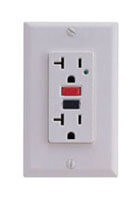
According to the National Electrical Code, in all kitchens, bathrooms, garages, or any area in which water may be present, instead of regular receptacles (outlets), GFI receptacles should be used. These are for your safety.
The idea of a GFI receptacle is that if there is the slightest electrical problem, the (ground fault interrupters) GFI immediately shuts off the power. This is an important safety feature.
When you lose power to a receptacle in a kitchen, bathroom, garage, or outdoor area, check to see if it’s a GFI receptacle. If it is, press the “TEST” button, then press the “RESET” button. If the GFI shuts off power repeatedly, plug in a different appliance to test whether the problem is the first appliance or the GFI itself. If the GFI is defective, call a good electrician.
Hint: You may have a receptacle that has lost power in a kitchen, bathroom, garage, or outdoor area but it’s not a GFI. It may be “protected” by a GFI that has tripped off somewhere else. You can check for this situation by making sure that all the GFIs in your kitchen, bathroom, garage, and outdoor areas are working properly.
More Technical Data About GFIs
A GFI receptacle (also called a GFCI receptacle) can measure differences in power as small as 3ma (which is a very small amount). When it detects more power coming in from the “hot” side than going out from the neutral side, it will shut off. This is a good thing because that extra electricity has to go somewhere, and it’s important to protect you and your family from it.
All GFI receptacles should be tested monthly. This is done by pressing the “TEST” button. If pressing the “TEST” button does not make the button labeled “RESET” pop out, then call an electrician. If the “RESET” button does pop out, the outlet is OK. Press the “RESET” button back in to reset the outlet.
Lighting Problems
Lighting Problems?
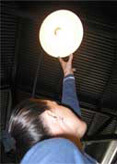
- Lights Not Turning On
- Lights Not Turning Off
- Lights Blinking On and Off
- Flickering Fluorescent Lights
- Bulbs Burning Out Too Quickly
- Humming Lights
- Lights Dimming
Lights Not Turning On
Lights don’t turn on for six basic reasons:
1. The bulb is bad. This is more common than one might think. Try replacing a questionable light bulb with a new one. If that doesn’t work, before giving up, try using a bulb from another light fixture that you KNOW is working.
2. The switch to the light is bad. The switch will need to be replaced.
3. The light fixture is broken. Usually it is easiest and least expensive to simply replace the fixture. However, many light fixtures can be repaired if it is desired.
4. No power.
5. The time clock for the light is not set for the correct time or is broken. Re-set the time or replace the broken time clock.
6. If the light fixture is activated by a photo-cell, the photo-cell is out of adjustment or broken. Adjust or replace the photo-cell.
7. Fluorescent, Mercury-Vapor, or High-Pressure-Sodium Lights. These kinds of light fixtures all use an electrical ballast to energize their special light bulbs. If the light is humming loudly or has an “electrical odor,” or if the light just doesn’t turn on, the ballast may need to be replaced.
Lights Not Turning Off
1. The switch to the light fixture is broken. Replace the switch.
2. The time clock for the light is broken or out of adjustment. Set the time clock to the right time. If it won’t stay adjusted, replace the time clock.
3. If the light fixture is activated by a photo-cell, the photo-cell is either out of adjustment or broken. Adjust or replace the photo-cell.
Lights Blinking On And Off
There are two main reasons for lights blinking on and off:
1. A photo-cell is out of adjustment. Adjust the photo-cell.
2. Some light fixtures that are recessed into the ceiling have a built-in thermal protector that automatically shuts off the light when the fixture gets too hot. Use a lower wattage bulb for a lower temperature.
Flickering Fluorescent Lights
There are three reasons fluorescent lights flicker:
1. For a few moments when they first turn on, the bulbs will flicker until they warm up. You will notice this more on colder days. Just wait a few moments for the bulbs to warm up.
2. The fluorescent bulbs are old. Replace them.
3. The fluorescent ballast is old. Replace it.
Bulbs Burning Out Too Quickly
Here are the three reasons bulbs can burn out quickly:
1. The wattage of the bulb is too high. This is very common. Most light fixtures with glass covers have a maximum rating of 60 watts per bulb. It is very common for people to put in 75 watt or even 100 watt bulbs. The result is bulbs burning out much too quickly. Use the correct wattage bulbs in all your light fixtures.
2. Poor-quality lights bulbs. Use only major-brand light bulbs.
3. Mysterious light fixture problems. It’s mysterious because the light fixture LOOKS perfectly fine, and even electricians can’t find anything wrong with it. Nevertheless, after checking #1 and #2 above, if the bulbs keep burning out,replace the light fixture.
Humming Lights
Humming lights can be caused by:
1. A bad ballast or bad transformer. Replace the ballast or transformer.
2. A conflict between a low-voltage dimmer and the low-voltage light fixture it controls. This is a tough one, but sometimes experimenting with different dimmers will lead you to one that doesn’t make the low-voltage light transformer hum.
Lights Dimming
Lights will sometimes dim for a few seconds and then come back to complete brightness again. This can happen when a light is connected to the same wires that provide power to an appliance that takes a lot of power, like a refrigerator, a microwave oven, or an air conditioner. The reason the light dims for a few seconds is that the appliance is using a lot of power when it first starts up. After the appliance is running for a few seconds, it will use less power, and the light will return to normal again. If you have central air-conditioning, the lights may dim each time the air conditioning comes on.
You will usually notice this dimming more at night (for obvious reasons!), but you might also notice it in the daytime. If this dimming bothers you, you can handle the problem by having an electrician add another circuit specifically for the appliance that is causing the dimming problem.
NOTE: If you haven’t changed anything electrical in your home or office, and you suddenly start to have dimming problems or power fluctuations, then you probably have a loose wire somewhere. You should contact an electrician skilled in troubleshooting to find and correct this problem.
Power Problems

Receptacles Controlled By Switches
In some homes and offices, a receptacle (outlet) on the wall is controlled by a light switch near the entrance to the room. This allows you to plug a lamp into the receptacle and turn it on and off with the switch.
If an appliance that is plugged into a receptacle has no power, first turn on all the light switches in the room. Sometimes the device will come on, which means that it’s controlled by a switch.
Hint: A receptacle usually has spaces for two plugs. Sometimes one is permanently energized and the other is controlled by a switch. This is known as a “half-hot” receptacle.
GFI Receptacles
In any location where there may be moisture (like kitchens, bathrooms, garages, and outdoors) special receptacles (outlets) are used for safety. These are called GFIs. The idea of a GFI receptacle is that with the slightest electrical problem, the GFI immediately shuts off the power. This is an important safety feature.
When you lose power to a receptacle in a kitchen, bathroom, garage, or outdoor area, check to see if it’s a GFI receptacle. There’s one pictured on this page. If it’s a GFI, you can restore power by pressing the “TEST” button and then pressing the “RESET” button. If the GFI shuts off power repeatedly, plug in a different appliance to test whether the problem is the first appliance or the GFI itself. If the GFI is defective, call a good electrician.
Hint: Sometimes, you may have a receptacle that has lost power in a kitchen, bathroom, garage, or outdoor area but it’s not a GFI. It may be “protected” by a GFI that has tripped off somewhere else. You can check for this situation by making sure that all the GFIs in your kitchen, bathroom, garage, and outdoor areas are working properly.
More Technical Stuff About GFIs
A GFI receptacle (also called a GFCI receptacle) can measure differences in power as small as 3ma (a very small amount). When the GFI detects more power coming in from the “hot” side than going out from the neutral side, it will shut off. This is a good thing because that extra electricity has to go somewhere, and it’s important to protect you and your family from it.
All GFI receptacles should be tested monthly. This is done by pressing the “TEST” button. If pressing the “TEST” button does not make the button labeled “RESET” pop out, then call an electrician. If the “RESET” button does pop out, the GFI is OK. Press in the “RESET” button to reset the GFI.
Circuit Breaker Tripped Off
The first thing to understand is that a circuit breaker can have tripped off even when it looks like it’s in the “ON” position. This is because a circuit breaker will sometimes trip off internally, without the “ON/OFF” handle flipping to the “OFF” position.
This is what to do when you have a loss of power that you suspect may be caused by a tripped circuit breaker.
1. Shut down any computer equipment that may be affected by a loss of power.
2. Go to your circuit breaker panel and firmly flip the first breaker OFF and then back ON again.
3. Do the same thing with each circuit breaker until you have flipped all of the circuit breakers OFF and then back ON again.
4. Now check and see whether the device that didn’t have power is now back on.
5. If your power has been restored, you’re done! If your power is still out, it’s time to call an electrician.
Note: About 25% of all electrical power problems can be solved using the above technique. Good Luck!
More Technical Stuff About Circuit Breakers
Inside most circuit breakers there are two types of protection: One is thermal. The other is magnetic. The thermal strip measures heat build-up caused by overloading. When it reaches a certain temperature, it will shut off the breaker. The magnetic coil measures sudden increases in current (such as a short). At a predetermined limit it will shut the breaker off. Older breakers sometimes have only one of these features. For maximum protection, a breaker with both types of protection is recommended.
There are usually three spots on the outside of a breaker that show wear. If the “ON/OFF” switch (located at the top) has broken off or is loose, we recommend the breaker be replaced. Next is the load lug. If it is burnt or abnormally loose, we recommend the breaker be replaced. Last, and most common, is the stab. The breaker stab is what makes contact with the bussing in the panel (the bussing carries the power throughout the panel). The stab connects to the bussing through friction and spring tension. The spring tension, over time, may break down. If so, arcing or burning may result. If the stab has become burnt, discolored, or is abnormally loose, we recommend that the breaker be replaced and that the bussing in the panel be checked.
NOTE: It is possible for a breaker to appear OK in regard to it’s outward appearance and its capacity to carry continuity, but still be questionable, bad, or intermittent. The opposite may be true as well. A breaker with a poor outward appearance may be perfectly safe and structurally sound. Therefore a decision to replace a breaker should not be based solely on appearance, continuity, age, etc. A good electrician can recommend the proper course of action based on taking into account all the relevant factors.
Short Circuits
Short Circuits occur when two electrical wires accidentally touch each other. A short circuit will immediately cause one of your circuit breakers to trip off or one of your fuses to blow.
To fix a short circuit, ask yourself this question: “What was happening right before the short circuit?” If you had just plugged something into a receptacle (outlet) or turned on a light or an appliance, then this gives you a clue.
If you just plugged in an iron, for instance, you can simply un-plug the iron and then re-set the circuit breaker or replace the fuse. If everything is now OK, then your electrical system is fine and it’s time to get a new iron!
If, however, you can’t find an appliance which is causing the problem, then it’s time to call a good electrician to locate and repair your short circuit.
No Power At All
When nothing works in the entire building this means:
A. The electrical power from the utility company is not getting to your electrical panel. Call the utility company.
B. The electrical power from the utility company is not getting to ANYBODY’S electrical panel. Wait for the utility company to restore power.
C. Your main circuit breaker is broken or turned off. Try to re-set the circuit breaker.
D. All your circuit breakers are flipped off. Re-set all breakers.
E. Something else. Time to call an electrician.
Refrigerator Power

If the power goes out to your refrigerator or freezer, you need to fix it fast! Here are two tips to help you quickly restore power:
1. If your refrigerator is plugged into a GFI receptacle (a receptacle is an outlet), you can re-set the GFI and see if you now have power. If this works, that’s great! Now that it’s working again you should make arrangements to replace the GFI with a regular receptacle as soon as possible.
Refrigerators should never be plugged into a GFI receptacle because GFIs are very sensitive, and you don’t want to be on vacation and lose power to your refrigerator just because the GFI accidentally shut off. So if your refrigerator is plugged into a GFI receptacle, you should replace the GFI with a regular receptacle.
2. If you can’t restore power to the receptacle that your refrigerator is plugged into, you should call an electrician who is good at troubleshooting to locate and fix the problem. But while you’re waiting for the electrician to arrive, you can plug the refrigerator into a heavy-duty extension cord and plug it in to a receptacle that has power.
This will keep your food cold and safe until your electrician arrives.
Smoke Detectors

Smoke detectors are great safety devices. But occasionally a smoke detector will start “chirping” or worse, sound a non-stop alarm for no reason. Here’s what you can do if this happens to you:
If it’s a battery-powered smoke detector, take out the battery and replace it with a new one. If there’s still a problem, replace the entire smoke detector.
If it’s a 120 Volt powered smoke detector (hard-wired), turn off your circuit breakers one by one until the noise stops. Then turn on all the circuit breakers again except the one controlling the smoke detector. Replace the faulty smoke detector and turn its circuit breaker back on again.
You will then need to replace the 120 Volt smoke detector or if it is a battery powered smoke detector, replace the battery.
Telephone Power
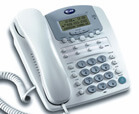
When power goes out in your home, remember, YOUR CORDLESS PHONE WILL NOT WORK IF THE PHONE’S BASE UNIT HAS NO POWER. However, if this happens you can still use any telephone that is plugged directly into a telephone outlet.
Whole House Surge Protector
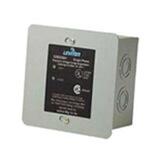
The need for surge protection has increased dramatically. This is because many electronic devices can be damaged by surges. Electronic devices sensitive to power surges occur in: security systems, computers, printers, FAX machines, telephones, small appliances, microwave ovens, refrigerators, stereos, garage door openers, and low-voltage lighting systems.
Anytime there is a power outage, there is the possibility of a power surge upon turning the power back on. Unfortunately, the cost of replacing electronic components can be monumental.
Finally there is a solution to the problem: “whole house” surge protection. Whole house surge protection is now available to the general public at a reasonable cost. Call our In-House Technician and he’ll be glad to discuss whether installing a whole house surge protector would be a good option for you.



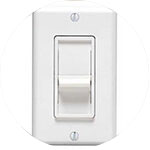

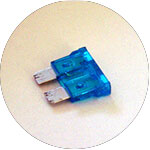

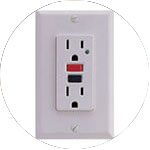
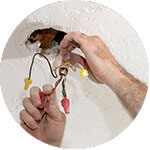



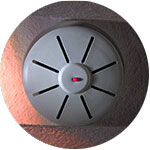
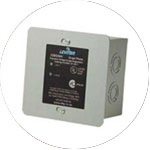
 Never connect a regular dimmer to low-voltage lights, paddle fans, or any kind or motor. These devices require special dimmers.
Never connect a regular dimmer to low-voltage lights, paddle fans, or any kind or motor. These devices require special dimmers.